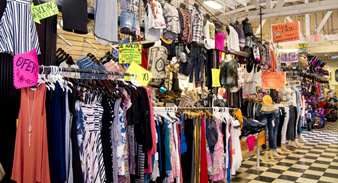Flea Market
Content
The term flea market originated with the French marché aux puces. It translates "market of the fleas" and referred to the most likely flea-infested used merchandise. Flea markets are markets where several suppliers collect to offer merchandise. Numerous flea markets today provide both brand-new and utilized goods. Though open-air markets were when the standard, today's flea markets might happen indoors, outdoors, or both.
An Event Within swap meet in Los AngelesAn Event
They established and offer their items from designated spaces called booths or stalls, which they rent from the flea market owners or organizers. Typically, each flea market supplier sticks with their cubicle and takes care of customer transactions. In the majority of today's irreversible indoor flea markets, suppliers stock and set up their booths, but they don't remain to deal with consumers. Deals are handled by flea market employees and the market pays the vendors on designated days.
Flea market
Technically, a swap meet is an event whether people swap mainly used product. Today, nevertheless, the majority of swap meet product is sold instead of traded and the term is used interchangeably with flea market.Vintage Show
A vintage show is a fairly brand-new term in the flea market world. It generally describes a periodic sale where the goods-- primarily home furnishings-- are trendy and desirable, however not old sufficient to be antiques. A lot of vintage programs are called curated markets, which normally means vendors are chosen on both the appeal of their merchandise and their talent in displaying it. The vintage items are often changed by restyling, upcycling, or repurposing.
Vintage Market
Classic market is another newish term and one that can describe numerous various kinds of sales, but in some cases, this is just another name for a vintage show. Producers of antique shows and upscale flea markets sometimes use the term to describe an unique vintage area of the sale and even a stand-alone spin-off occasion. Some indoor cubicle shopping malls are likewise called classic markets instead of indoor flea markets or antique shopping malls.
Pop-Up Market

Interior flea market in Los AngelesFlea Market In Miami, Fl
Aesthetically, a pop-up market looks no different than an indoor or outdoor flea market selling similar types of merchandise. The term refers to the market location and schedule. Instead of taking place on a regular schedule, a pop-up market pops up somewhere-- and not always on a regularly-scheduled date.You will encounter single-location markets incorrectly calling themselves pop-up markets just because the term is trendy. If the event happens in a regular place at a regular time, it is not a pop-up market.
Antique shows are indoor or outdoor sales featuring primarily merchandise that is at least 100 years old. Antique show goods are typically finer and pricier than those at the average flea markets. Some antique shows, such as the Springfield Antique Show, are priced to appeal to both resellers and private buyers, while others cater primarily to collectors.
- If the occasion occurs in a routine place at a regular time, it is not a pop-up market.
- What about antique malls, antique shows, vintage programs, and also classic markets?
- So secure some money as well as, yes, haggling is allowed.

Antique Shopping center Antique malls are indoor stores. Like flea markets, they lease cubicle area to several vendors. Antique malls are regularly equivalent from long-term indoor flea markets.
Some antique shopping centers take the antique part of the term seriously and they require that a defined portion of the product be at least 100 years old. Others use the word antique interchangeably with vintage; they simply anticipate the goods to be old. Some call their services antique shopping centers, but they in fact offer whatever from expired cosmetics to garage sale fare.
Panorama Los Angeles swap meetIncredibly Market
A flea market (or swap meet) is a type of street market that provides space for suppliers to offer previously-owned (second-hand) merchandise. This kind of market is frequently seasonal. However, recently there has been the advancement of 'official' and 'casual' markets which divides a fixed-style market (formal) with long-term leases and a seasonal-style market with short-term leases. Regularly, there tends to be a focus on sustainable usage whereby products such as utilized goods, collectibles, antiques and classic clothes can be purchased.
Flea market vending is distinguished from street vending because the marketplace alone, and not any other public attraction, generates purchasers. There are a variety of vendors: some part-time who consider their work at flea markets a pastime due to their belongings of an alternative job; full-time vendors who commit all their time to their stalls and collection of product and rely solely on the profits made at the marketplace. [3] Vendors require ability in following retro and vintage patterns, as well as selecting product which connects with the swap meet in Los Angeles culture and identity of their customers.
In the United States, the National Association of Flea Markets was developed in 1997, which offers various resources for sellers, suppliers and purchasers and also provides a method for suppliers and sellers to communicate and form associations.